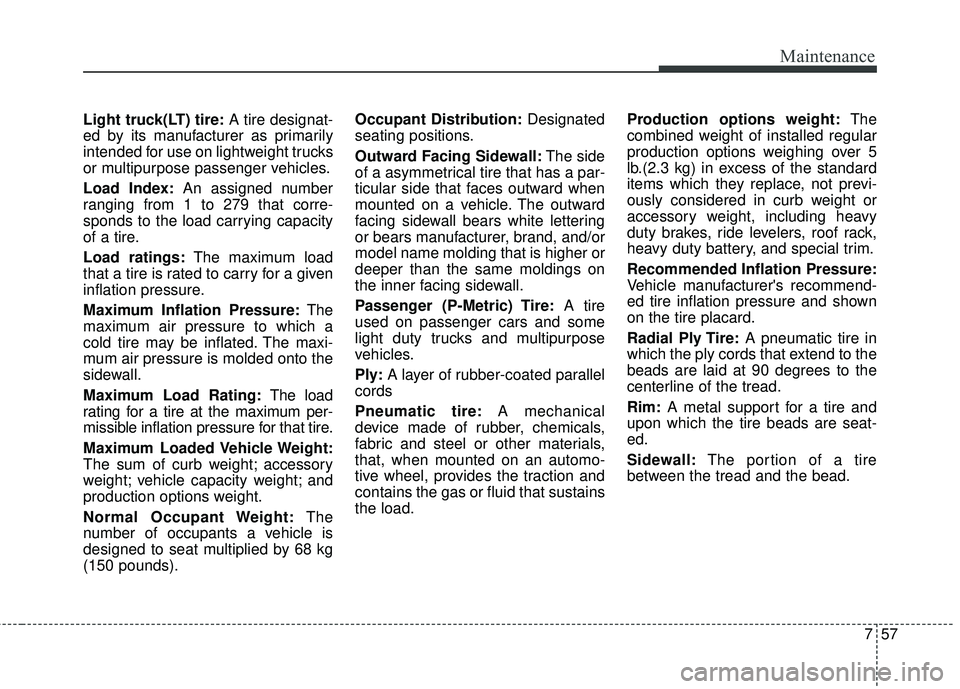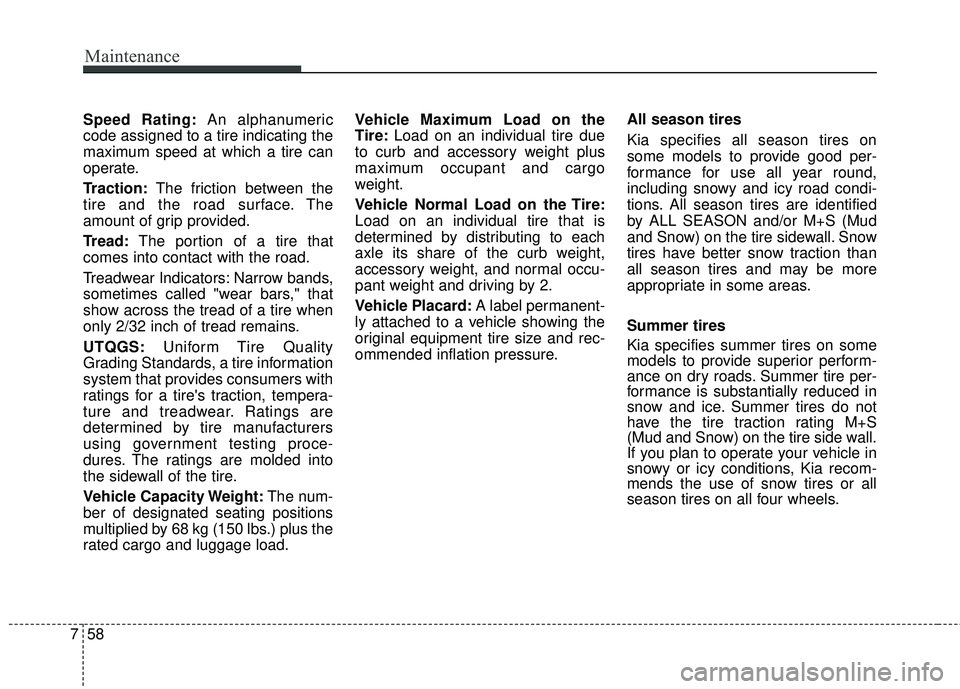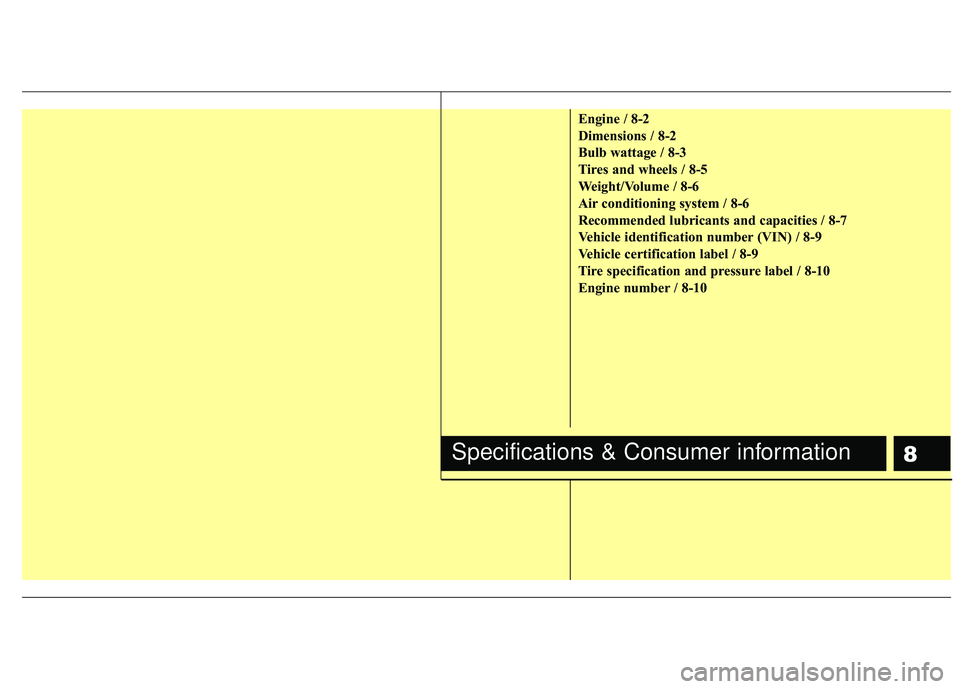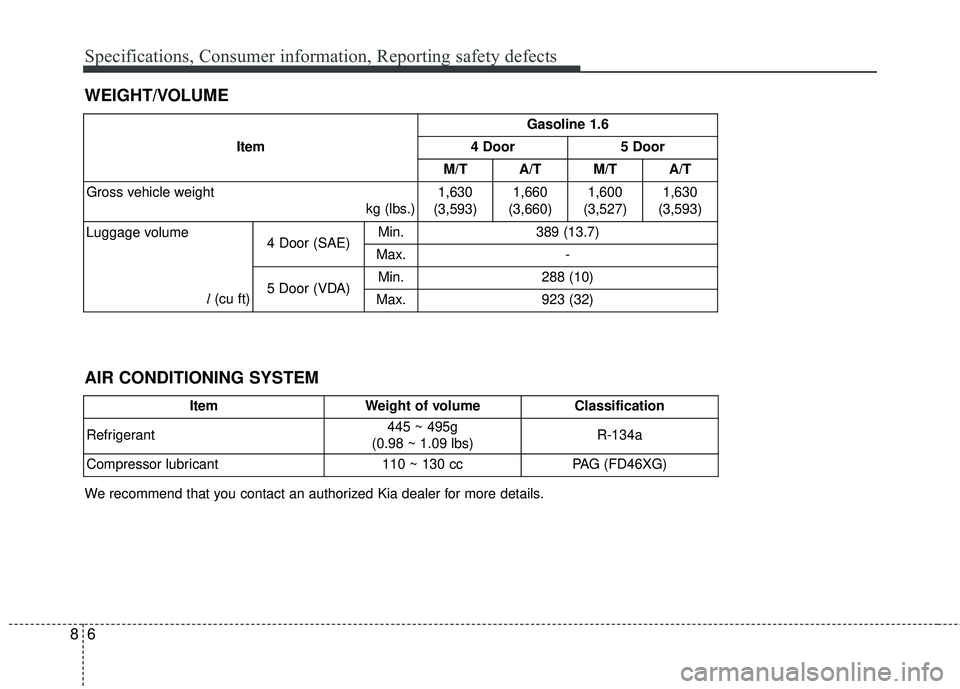2017 KIA RIO weight
[x] Cancel search: weightPage 392 of 449

Maintenance
56
7
Temperature -A, B & C
The temperature grades are A (the
highest), B and C representing the
tire’s resistance to the generation of
heat and its ability to dissipate heat
when tested under controlled condi-
tions on a specified indoor laboratory
test wheel.
Sustained high temperature can
cause the material of the tire to
degenerate and reduce tire life, and
excessive temperature can lead to
sudden tire failure. Grades B and A
represent higher levels of perform-
ance on the laboratory test wheel
than the minimum required by law. Tire terminology and definitions
Air Pressure:
The amount of air
inside the tire pressing outward on
the tire. Air pressure is expressed in
kilopascal (kPa) or pounds per
square inch (psi).
Accessory Weight: This means the
combined weight of optional acces-
sories. Some examples of optional
accessories are, automatic
transaxle, power seats, and air con-
ditioning.
Aspect Ratio: The relationship of a
tire's height to its width.
Belt: A rubber coated layer of cords
that is located between the plies and
the tread. Cords may be made from
steel or other reinforcing materials.
Bead: The tire bead contains steel
wires wrapped by steel cords that
hold the tire onto the rim.
Bias Ply Tire: A pneumatic tire in
which the plies are laid at alternate
angles less than 90 degrees to the
centerline of the tread. Cold Tire Pressure:
The amount of
air pressure in a tire, measured in
kilopascals (kPa) or pounds per
square inch (psi) before a tire has
built up heat from driving.
Curb Weight: This means the weight
of a motor vehicle with standard and
optional equipment including the
maximum capacity of fuel, oil and
coolant, but without passengers and
cargo.
DOT Markings: The DOT code
includes the Tire Identification
Number (TIN), an alphanumeric des-
ignator which can also identify the
tire manufacturer, production plant,
brand and date of production.
GVWR: Gross Vehicle Weight Rating
GAWR FRT: Gross Axle Weight
Rating for the Front Axle.
GAWR RR: Gross Axle Weight
Rating for the Rear axle.
Intended Outboard Sidewall: The
side of an asymmetrical tire, that
must always face outward when
mounted on a vehicle.
Kilopascal (kPa): The metric unit for
air pressure.
Page 393 of 449

757
Maintenance
Light truck(LT) tire:A tire designat-
ed by its manufacturer as primarily
intended for use on lightweight trucks
or multipurpose passenger vehicles.
Load Index: An assigned number
ranging from 1 to 279 that corre-
sponds to the load carrying capacity
of a tire.
Load ratings: The maximum load
that a tire is rated to carry for a given
inflation pressure.
Maximum Inflation Pressure: The
maximum air pressure to which a
cold tire may be inflated. The maxi-
mum air pressure is molded onto the
sidewall.
Maximum Load Rating: The load
rating for a tire at the maximum per-
missible inflation pressure for that tire.
Maximum Loaded Vehicle Weight:
The sum of curb weight; accessory
weight; vehicle capacity weight; and
production options weight.
Normal Occupant Weight: The
number of occupants a vehicle is
designed to seat multiplied by 68 kg
(150 pounds). Occupant Distribution:
Designated
seating positions.
Outward Facing Sidewall: The side
of a asymmetrical tire that has a par-
ticular side that faces outward when
mounted on a vehicle. The outward
facing sidewall bears white lettering
or bears manufacturer, brand, and/or
model name molding that is higher or
deeper than the same moldings on
the inner facing sidewall.
Passenger (P-Metric) Tire: A tire
used on passenger cars and some
light duty trucks and multipurpose
vehicles.
Ply: A layer of rubber-coated parallel
cords
Pneumatic tire: A mechanical
device made of rubber, chemicals,
fabric and steel or other materials,
that, when mounted on an automo-
tive wheel, provides the traction and
contains the gas or fluid that sustains
the load. Production options weight:
The
combined weight of installed regular
production options weighing over 5
lb.(2.3 kg) in excess of the standard
items which they replace, not previ-
ously considered in curb weight or
accessory weight, including heavy
duty brakes, ride levelers, roof rack,
heavy duty battery, and special trim.
Recommended Inflation Pressure:
Vehicle manufacturer's recommend-
ed tire inflation pressure and shown
on the tire placard.
Radial Ply Tire: A pneumatic tire in
which the ply cords that extend to the
beads are laid at 90 degrees to the
centerline of the tread.
Rim: A metal support for a tire and
upon which the tire beads are seat-
ed.
Sidewall: The portion of a tire
between the tread and the bead.
Page 394 of 449

Maintenance
58
7
Speed Rating: An alphanumeric
code assigned to a tire indicating the
maximum speed at which a tire can
operate.
Traction: The friction between the
tire and the road surface. The
amount of grip provided.
Tread: The portion of a tire that
comes into contact with the road.
Treadwear Indicators: Narrow bands,
sometimes called "wear bars," that
show across the tread of a tire when
only 2/32 inch of tread remains.
UTQGS: Uniform Tire Quality
Grading Standards, a tire information
system that provides consumers with
ratings for a tire's traction, tempera-
ture and treadwear. Ratings are
determined by tire manufacturers
using government testing proce-
dures. The ratings are molded into
the sidewall of the tire.
Vehicle Capacity Weight: The num-
ber of designated seating positions
multiplied by 68 kg (150 lbs.) plus the
rated cargo and luggage load. Vehicle Maximum Load on the
Tire:
Load on an individual tire due
to curb and accessory weight plus
maximum occupant and cargo
weight.
Vehicle Normal Load on the Tire:
Load on an individual tire that is
determined by distributing to each
axle its share of the curb weight,
accessory weight, and normal occu-
pant weight and driving by 2.
Vehicle Placard: A label permanent-
ly attached to a vehicle showing the
original equipment tire size and rec-
ommended inflation pressure. All season tires
Kia specifies all season tires on
some models to provide good per-
formance for use all year round,
including snowy and icy road condi-
tions. All season tires are identified
by ALL SEASON and/or M+S (Mud
and Snow) on the tire sidewall. Snow
tires have better snow traction than
all season tires and may be more
appropriate in some areas.
Summer tires
Kia specifies summer tires on some
models to provide superior perform-
ance on dry roads. Summer tire per-
formance is substantially reduced in
snow and ice. Summer tires do not
have the tire traction rating M+S
(Mud and Snow) on the tire side wall.
If you plan to operate your vehicle in
snowy or icy conditions, Kia recom-
mends the use of snow tires or all
season tires on all four wheels.
Page 404 of 449

Maintenance
68
7
Instrument panel fuse panel
Fuse Name Fuse rating Circuit Protected
POWER OUTLET 15A Power Outlet
C/LIGHTER 20A Cigarette Lighter
ACC 10AFront Map Lamp, Power Outside Mirror Switch, BCM,
Low DC-DC Convertor, Smart Key Control Module, Audio,
A/V & Navigation Head Unit, Digital Clock
A/BAG IND 10A Instrument Cluster
A/BAG 10ASBR PAB Indicator, SRS Control Module
Passenger Weight Classification Sensor
MODULE 2 10A BCM
MDPS 10A EPS Control Module
WIPER RR 15A Multifunction Switch, Rear Wiper Relay, Rear Wiper Motor
HTD STRG 15A Steering Wheel Heater
FOG LAMP RR 10A -
FOG LAMP FRT 15A Front Fog Lamp Relay
MODULE 1 10A ATM Shift Lever Switch, Door Warning Switch
STOP LAMP 15AData Link Connector, Smart Key Control Module, Stop Lamp Switch
Stop Lamp Relay, PCB Fuse & Relay Box (HAC Relay)
CLUSTER 10AAudio, BCM, ATM Shift Lever ILL., Crash Pad Switch
Instrument Cluster, Tire Pressure Monitoring Module
IG1 1 10AMultipurpose Check Connector, Driver CCS Seat Warmer Module
Passenger Seat Warmer Module
With ISG : Crash Pad Switch, Low DC-DC Convertor
ABS 10ACrash Pad Switch, ESC Module
PCB Fuse & Relay Box (HAC Relay)
B/UP LAMP 10A Back-Up Lamp Switch
Page 431 of 449

Engine / 8-2
Dimensions / 8-2
Bulb wattage / 8-3
Tires and wheels / 8-5
Weight/Volume / 8-6
Air conditioning system / 8-6
Recommended lubricants and capacities / 8-7
Vehicle identification number (VIN) / 8-9
Vehicle certification label / 8-9
Tire specification and pressure label / 8-10
Engine number / 8-10
Specifications & Consumer information8
Page 436 of 449

Specifications, Consumer information, Reporting safety defects
68
WEIGHT/VOLUME
ItemGasoline 1.6
4 Door 5 Door
M/T A/T M/T A/T
Gross vehicle weight kg (lbs.)1,630
(3,593) 1,660
(3,660) 1,600
(3,527) 1,630
(3,593)
Luggage volume
l(cu ft) 4 Door (SAE)
Min.389 (13.7)
Max.-
5 Door (VDA)
Min.288 (10)
Max.923 (32)
ItemWeight of volume Classification
Refrigerant
445 ~ 495g
(0.98 ~ 1.09 lbs) R-134a
Compressor lubricant
110 ~ 130 cc PAG (FD46XG)
AIR CONDITIONING SYSTEM
We recommend that you contact an authorized Kia dealer for more details.
Page 448 of 449

Index
8I
THEFT-ALARM SYSTEM··················\
··················\
·······4-13Armed stage ··················\
··················\
··················\
···········4-13
Disarmed stage ··················\
··················\
··················\
······4-14
Theft-alarm stage ··················\
··················\
··················\
···4-14
Tire Pressure Monitoring System (TPMS) ··················\
····6-9 Changing a tire with TPMS··················\
··················\
·····6-12
Low tire pressure telltale ··················\
··················\
·········6-10
TPMS (Tire Pressure Monitoring System)malfunction indicator ··················\
··················\
············6-11
Tire specification and pressure label ··················\
···········8-10
Tires and Wheels ··················\
··················\
··················\
·····7-48 All season tires ··················\
··················\
··················\
·····7-58
Checking tire inflation pressure ··················\
················7-49
Low aspect ratio tire ··················\
··················\
················7-59
Radial-ply tires ··················\
··················\
··················\
······7-59
Recommended cold tire inflation pressures ················7-48
Snow tires ··················\
··················\
··················\
··············7-59
Summer tires··················\
··················\
··················\
··········7-58
Tire care ··················\
··················\
··················\
·················7-48\
Tire maintenance ··················\
··················\
··················\
···7-52
Tire replacement ··················\
··················\
··················\
····7-51
Tire rotation ··················\
··················\
··················\
···········7-50
Tire sidewall labeling ··················\
··················\
··············7-53
Tire traction ··················\
··················\
··················\
···········7-52
Wheel alignment and tire balance ··················\
·············7-51
Wheel replacement ··················\
··················\
··················\
7-52
Tires and wheels ··················\
··················\
··················\
········8-5 Towing ··················\
··················\
··················\
··················\
···6-28
Emergency towing ··················\
··················\
··················\
·6-30
Removable towing hook (Front) ··················\
···············6-29
Towing service··················\
··················\
··················\
·······6-28
Trunk (4 Door)··················\
··················\
··················\
·········4-20 Closing the trunk ··················\
··················\
··················\
···4-21
Emergency trunk safety release··················\
·················4-21\
Opening the trunk ··················\
··················\
··················\
··4-20
Vehicle break-in process ··················\
··················\
··············1-5
Vehicle certification label ··················\
··················\
············8-9
Vehicle data collection and event data recorders·············1-6
Vehicle identification number (VIN) ··················\
·············8-9
Vehicle load limit ··················\
··················\
··················\
·····5-53 Certification label ··················\
··················\
··················\
··5-56
Tire and loading information label ··················\
············5-53
Vehicle weight ··················\
··················\
··················\
·········5-58
Washer fluid ··················\
··················\
··················\
·············7-40 Checking the washer fluid level ··················\
················7-40
Weight/Volume ··················\
··················\
··················\
··········8-6
Windows ··················\
··················\
··················\
··················\
4-24 Manual windows ··················\
··················\
··················\
···4-27
Power windows··················\
··················\
··················\
······4-25
V
W
Page 449 of 449

I9
Index
Windshield defrosting and defogging··················\
········4-105Automatic climate control system ··················\
···········4-106
Defogging logic ··················\
··················\
··················\
···4-107
Manual climate control system ··················\
···············4-105
Winter driving ··················\
··················\
··················\
··········5-50 Carry emergency equipment··················\
··················\
····5-52
Change to "winter weight" oil if necessary·················5-51\
Check battery and cables ··················\
··················\
·········5-51
Check spark plugs and ignition system ··················\
·····5-51
Don't let ice and snow accumulate underneath ···········5-52
Don't let your parking brake freeze ··················\
···········5-52
Snowy or Icy conditions ··················\
··················\
··········5-50
To keep locks from freezing ··················\
··················\
····5-51
Use approved window washer anti-freeze in system ···5-51
Use high quality ethylene glycol coolant ··················\
··5-51
Wiper blades ··················\
··················\
··················\
············7-42 Blade inspection ··················\
··················\
··················\
····7-42
Blade replacement ··················\
··················\
··················\
·7-43
Wipers and washers ··················\
··················\
··················\
·4-77 Rear window wiper and washer switch (5 Door)········4-80
Windshield washers ··················\
··················\
·················4-79\
Windshield wipers ··················\
··················\
··················\
·4-78